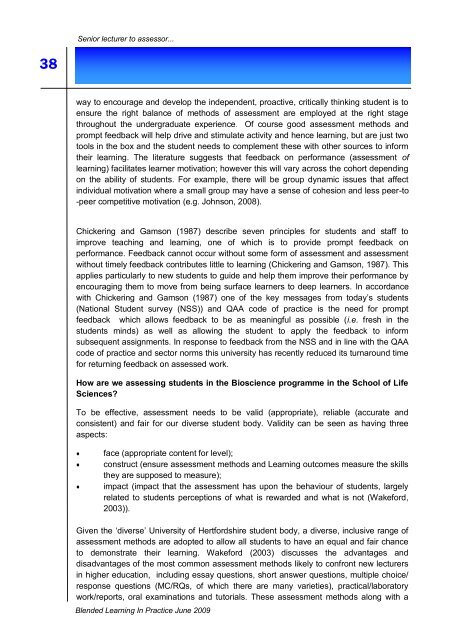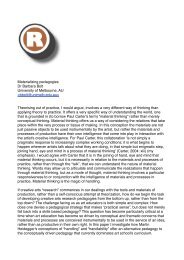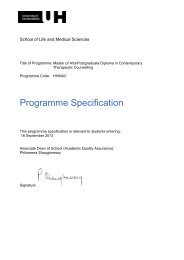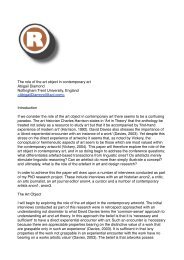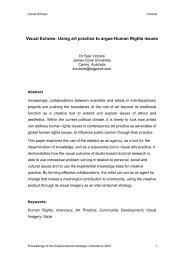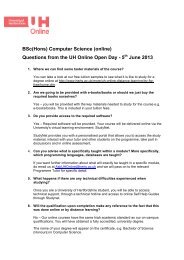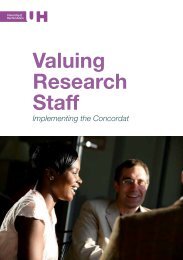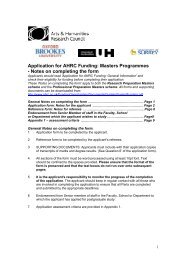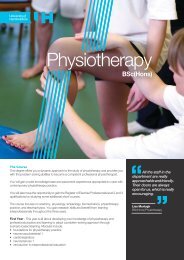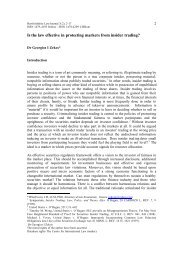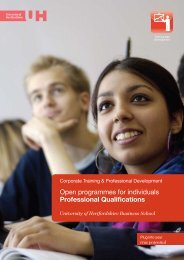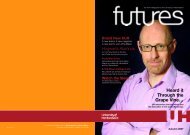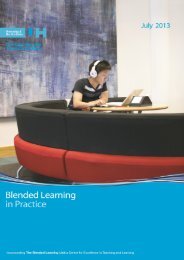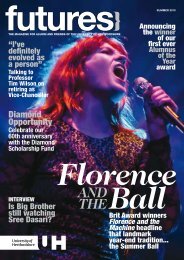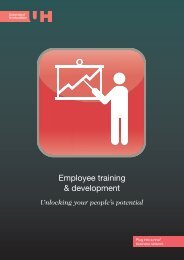June 2009 - University of Hertfordshire
June 2009 - University of Hertfordshire
June 2009 - University of Hertfordshire
Create successful ePaper yourself
Turn your PDF publications into a flip-book with our unique Google optimized e-Paper software.
Senior lecturer to assessor...<br />
38<br />
way to encourage and develop the independent, proactive, critically thinking student is to<br />
ensure the right balance <strong>of</strong> methods <strong>of</strong> assessment are employed at the right stage<br />
throughout the undergraduate experience. Of course good assessment methods and<br />
prompt feedback will help drive and stimulate activity and hence learning, but are just two<br />
tools in the box and the student needs to complement these with other sources to inform<br />
their learning. The literature suggests that feedback on performance (assessment <strong>of</strong><br />
learning) facilitates learner motivation; however this will vary across the cohort depending<br />
on the ability <strong>of</strong> students. For example, there will be group dynamic issues that affect<br />
individual motivation where a small group may have a sense <strong>of</strong> cohesion and less peer-to<br />
-peer competitive motivation (e.g. Johnson, 2008).<br />
Chickering and Gamson (1987) describe seven principles for students and staff to<br />
improve teaching and learning, one <strong>of</strong> which is to provide prompt feedback on<br />
performance. Feedback cannot occur without some form <strong>of</strong> assessment and assessment<br />
without timely feedback contributes little to learning (Chickering and Gamson, 1987). This<br />
applies particularly to new students to guide and help them improve their performance by<br />
encouraging them to move from being surface learners to deep learners. In accordance<br />
with Chickering and Gamson (1987) one <strong>of</strong> the key messages from today‟s students<br />
(National Student survey (NSS)) and QAA code <strong>of</strong> practice is the need for prompt<br />
feedback which allows feedback to be as meaningful as possible (i.e. fresh in the<br />
students minds) as well as allowing the student to apply the feedback to inform<br />
subsequent assignments. In response to feedback from the NSS and in line with the QAA<br />
code <strong>of</strong> practice and sector norms this university has recently reduced its turnaround time<br />
for returning feedback on assessed work.<br />
How are we assessing students in the Bioscience programme in the School <strong>of</strong> Life<br />
Sciences?<br />
To be effective, assessment needs to be valid (appropriate), reliable (accurate and<br />
consistent) and fair for our diverse student body. Validity can be seen as having three<br />
aspects:<br />
face (appropriate content for level);<br />
construct (ensure assessment methods and Learning outcomes measure the skills<br />
they are supposed to measure);<br />
impact (impact that the assessment has upon the behaviour <strong>of</strong> students, largely<br />
related to students perceptions <strong>of</strong> what is rewarded and what is not (Wakeford,<br />
2003)).<br />
Given the „diverse‟ <strong>University</strong> <strong>of</strong> <strong>Hertfordshire</strong> student body, a diverse, inclusive range <strong>of</strong><br />
assessment methods are adopted to allow all students to have an equal and fair chance<br />
to demonstrate their learning. Wakeford (2003) discusses the advantages and<br />
disadvantages <strong>of</strong> the most common assessment methods likely to confront new lecturers<br />
in higher education, including essay questions, short answer questions, multiple choice/<br />
response questions (MC/RQs, <strong>of</strong> which there are many varieties), practical/laboratory<br />
work/reports, oral examinations and tutorials. These assessment methods along with a<br />
Blended Learning In Practice <strong>June</strong> <strong>2009</strong>


